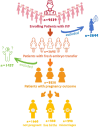Critical factors influencing live birth rates in fresh embryo transfer for IVF: insights from cluster ensemble algorithms
- PMID: 39881210
- PMCID: PMC11779932
- DOI: 10.1038/s41598-025-88210-1
Critical factors influencing live birth rates in fresh embryo transfer for IVF: insights from cluster ensemble algorithms
Abstract
Infertility has emerged as a significant global health concern. Assisted reproductive technology (ART) assists numerous infertile couples in conceiving, yet some experience repeated, unsuccessful cycles. This study aims to identify the pivotal clinical factors influencing the success of fresh embryo transfer of in vitro fertilization (IVF). We introduce a novel Non-negative Matrix Factorization (NMF)-based Ensemble algorithm (NMFE). By combining feature matrices from NMF, accelerated multiplicative updates for non-negative matrix factorization (AMU-NMF), and the generalized deep learning clustering (GDLC) algorithm. NMFE exhibits superior accuracy and reliability in analyzing the in vitro fertilization and embryo transfer (IVF-ET) dataset. The dataset comprises 2238 cycles and 85 independent clinical features, categorized into 13 categories based on feature correlation. Subsequently, the NMFE model was trained and reached convergence. Then the features of 13 categories were sequentially masked to analyze their individual effects on IVF-ET live births. The NMFE analysis highlights the significant influence of therapeutic interventions, Embryo transfer outcomes, and ovarian response assessment on live births of IVF-ET. Therapeutic interventions, including ovarian stimulation protocols, ovulation stimulation drugs, and pre-and intra-stimulation cycle acupuncture play prominent roles. However, their impacts on the IVF-ET model are reduced, suggesting a potential synergistic effect when combined. Conversely, factors like basic information, diagnosis, and obstetric history have a lesser influence. The NMFE algorithm demonstrates promising potential in assessing the influence of clinical features on live births in IVF fresh embryo transfer.
Keywords: Acupuncture; Cluster ensemble algorithm; IVF-ET; Influence factors; Synergistic effects.
© 2025. The Author(s).
Conflict of interest statement
Competing interests: The authors declare no competing interests.
Figures






Similar articles
-
Constructing a predictive model for live birth following fresh embryo transfer in antagonist protocol for polycystic ovary syndrome.J Assist Reprod Genet. 2024 Oct;41(10):2709-2719. doi: 10.1007/s10815-024-03232-4. Epub 2024 Aug 21. J Assist Reprod Genet. 2024. PMID: 39168929
-
Day three versus day two embryo transfer following in vitro fertilization or intracytoplasmic sperm injection.Cochrane Database Syst Rev. 2016 Dec 14;12(12):CD004378. doi: 10.1002/14651858.CD004378.pub3. Cochrane Database Syst Rev. 2016. PMID: 27976360 Free PMC article.
-
Cleavage-stage versus blastocyst-stage embryo transfer in assisted reproductive technology.Cochrane Database Syst Rev. 2022 May 19;5(5):CD002118. doi: 10.1002/14651858.CD002118.pub6. Cochrane Database Syst Rev. 2022. PMID: 35588094 Free PMC article.
-
Autologous platelet-rich plasma for assisted reproduction.Cochrane Database Syst Rev. 2024 Apr 29;4(4):CD013875. doi: 10.1002/14651858.CD013875.pub2. Cochrane Database Syst Rev. 2024. PMID: 38682756 Free PMC article.
-
Growth hormone for in vitro fertilisation (IVF).Cochrane Database Syst Rev. 2021 Nov 22;11(11):CD000099. doi: 10.1002/14651858.CD000099.pub4. Cochrane Database Syst Rev. 2021. PMID: 34808697 Free PMC article.
References
-
- Hornstein, M. D. State of the ART: Assisted Reproductive technologies in the United States. Reprod. Sci.23 (12), 1630–1633 (2016). - PubMed
-
- Bellver, J. & Donnez, J. Introduction: Infertility etiology and offspring health. Fertil. Steril.111 (6), 1033–1035 (2019). - PubMed
-
- Min, J. K. et al. What is the most relevant standard of success in assisted reproduction? The singleton, term gestation, live birth rate per cycle initiated: The BESST endpoint for assisted reproduction. Hum. Reprod.19 (1), 3–7 (2004). - PubMed
Publication types
MeSH terms
Grants and funding
- 2022YFS0036/Science and Technology Department of Sichuan Province
- ZYYCXTD-D-202003/Innovation Team and Talents Cultivation Program of National Administration of Traditional Chinese Medicine
- 2023MD744127/This study was supported by China Postdoctoral Science Foundation
- 82174517/National Natural Science Foundation of China
LinkOut - more resources
Full Text Sources

